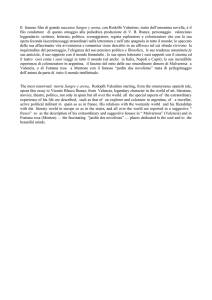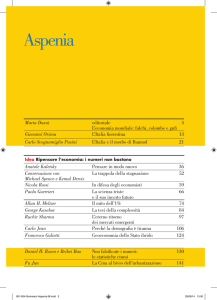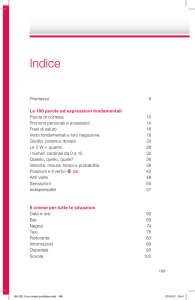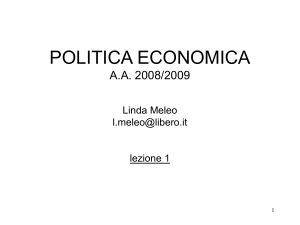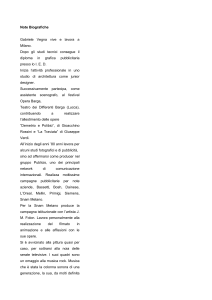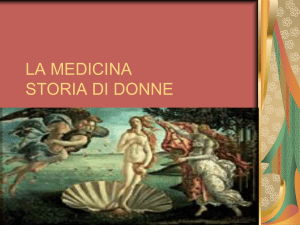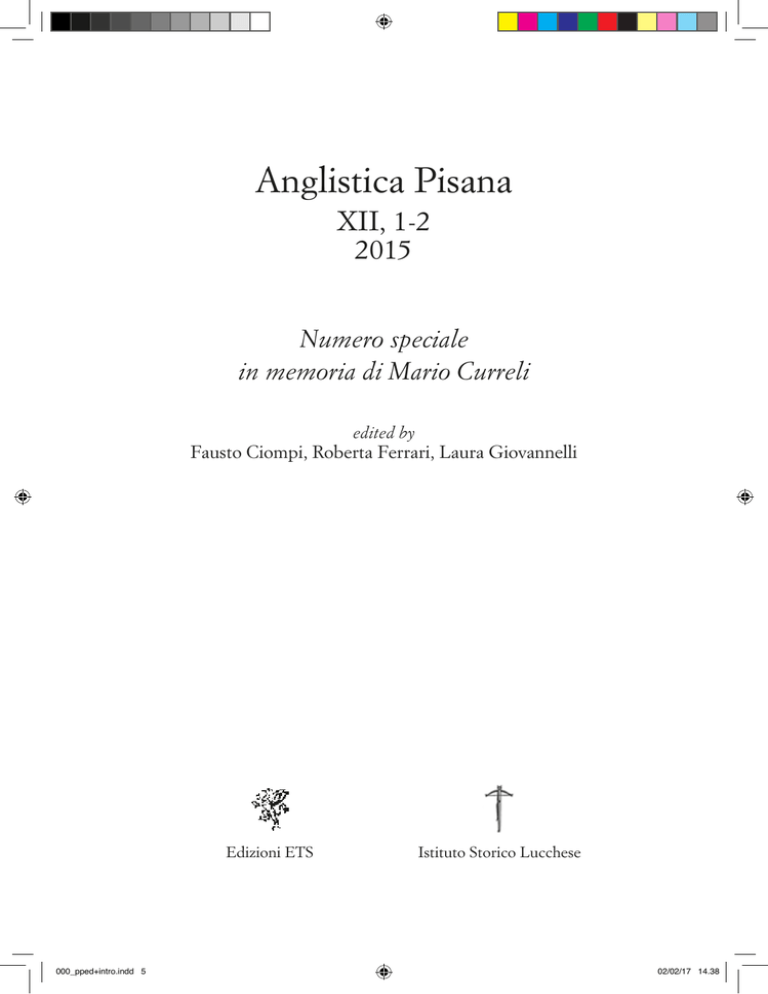
Anglistica Pisana
XII, 1-2
2015
Numero speciale
in memoria di Mario Curreli
edited by
Fausto Ciompi, Roberta Ferrari, Laura Giovannelli
Edizioni ETS
000_pped+intro.indd 5
Istituto Storico Lucchese
02/02/17 14.38
Questo fascicolo è pubblicato con contributi
del Ministero dei Beni Culturali, dell’Università di Pisa,
dell’Istituto Storico Lucchese
e del Prof. Tony Bareham (Ulster, Emeritus).
This peer-reviewed journal is indexed and/or abstracted
in ABELL, MLA International Bibliography,
The Scriblerian.
000_pped+intro.indd 6
02/02/17 14.38
INDICE
Introduzione
FAUSTO CIOMPI, ROBERTA FERRARI, LAURA GIOVANNELLI
9
FRANCESCO MARRONI, The Other Side of Romantic Ecology: John Clare’s
Poetry of Disharmony
11
FABIO FLEGO, ‘Straccato’ sulla spiaggia: Percy Bysshe Shelley a Viareggio
25
STEPHEN J. COFFEY, Recollections of an English Sailor
in the mid-19th Century, with Special Reference to Messina, 1848
35
GIGLIOLA SACERDOTI MARIANI, George Eliot turista e studiosa a Firenze
49
ROBERTA FERRARI, Intellectual Affinities: l’amicizia tra Walter Savage
Landor e Charles Dickens
61
RICHARD AMBROSINI, The Secret Agent: An Anti-Classic
79
FELICE POZZO, Mario Curreli tra Conrad e Salgari
91
TANIA ZULLI, “Flashes of a fine weird imagination…”: Henry Rider Haggard
e l’estetica del romance
97
MARIA TERESA CHIALANT, Politics, Gender and the First World War:
Rose Allatini’s Despised and Rejected (1918)
109
ELISABETTA D’ERME, Mr Canvasser Bloom
121
FAUSTO CIOMPI, Poesie-titolo e poesie-cornice: emblematizzazione e ritualità
nell’opera di Ted Hughes
133
LAURA GIOVANNELLI, Africanizing Modernism: osservazioni su Occasion
for Loving di Nadine Gordimer
153
FRANCA FARNOCCHIA PETRI, No Great Mischief di Alistair MacLeod
177
000_pped+intro.indd 7
14/03/17 13.17
000_pped+intro.indd 8
02/02/17 14.38
INTRODUZIONE
Mario Curreli fondò Anglistica Pisana nel 2004, quando era direttore del Dipartimento di Anglistica presso l’Università di Pisa. Sotto la sua direzione, la rivista
ha svolto, per oltre un decennio, tre funzioni culturali di primaria importanza: ha
fornito un orizzonte e un denominatore comune alle ricerche degli studiosi dell’ateneo pisano, interfacciandole con l’attività di alcuni fra i migliori specialisti italiani e
internazionali; ha consentito a giovani ricercatori di muovere i loro primi passi entro
la comunità scientifica di riferimento; ha promosso gli interscambi fra l’accademia e
il territorio, fra il territorio e un ambito di studi internazionale, raccogliendo gli atti
dei convegni annualmente organizzati da Curreli a Bagni di Lucca in collaborazione
con la Fondazione Michel de Montaigne, fra i quali si ricordano, a titolo di esempio,
il convegno su Ouida del 2008, quello sui Trollope del 2010 o quello sulla letteratura di viaggio del 2013.
Il filo rosso che ha legato queste attività di Curreli, ma potremmo dire la sua intera vita professionale, è la passione, una passione pura, totale, per la letteratura o,
meglio, per la cultura. Curreli credeva nella funzione civilizzatrice dell’insegnamento, nella necessità di trasmettere i valori umanistici alle nuove generazioni. E credeva
fermamente nella ricerca, che ha sempre sostenuto con energia, apertura mentale e
ampiezza di orizzonti. A queste istanze hanno cercato di rispondere anche le riviste
che Curreli ha diretto nell’arco della sua carriera, e, in particolare, Anglistica Pisana,
la sua ultima grande ‘scommessa’.
Ed è quindi naturale che, proprio sulle pagine di un numero speciale della nostra
rivista, a poco più di un anno dalla scomparsa di Mario, amici, colleghi ed allievi
rendano omaggio al Curreli studioso competente ed erudito, all’uomo discreto e
garbato, sempre pronto a riconoscere i meriti altrui e a glissare sui propri, all’editor
implacabilmente minuzioso e intellettualmente curioso, attento agli sviluppi della
ricerca ma, allo stesso tempo, capace di distinguere fra le mode del momento e le
implicazioni più serie della critica letteraria. Parafrasando Tom Stoppard, “one who
gave support by the bucket and for himself pretended it, if at all, by the grain”.
Fausto Ciompi, Roberta Ferrari, Laura Giovannelli
Anglistica Pisana, XII, 1-2 (2015)
000_pped+intro.indd 9
02/02/17 14.38
000_pped+intro.indd 10
02/02/17 14.38
FRANCESCO MARRONI
THE OTHER SIDE OF ROMANTIC ECOLOGY:
JOHN CLARE’S POETRY OF DISHARMONY
Abstract. John Clare constructs his poetic identity by establishing a problematic relationship
with the romantic tradition and by using his poetry as a destabilizing element of the literary
canon through his idiosyncratic use of the English language. Although Clare is often represented
as an epigone of Wordsworth, his poetic personality is very different from Wordsworth’s and
Coleridge’s because he rejects the prioritization of the ego in his dialogue with the natural world,
placing emphasis instead on the disharmony that characterizes nature. In this sense, above all in
his mature works, Clare refutes the tradition that depicts the natural environment as a locus of
harmonising beauty and serenity, to embrace a realistic conception, in which everything – including harmony – is always on the verge of dissolution. Thus, his green language has one of its privileged referents in ornithology precisely because birds are the metaphor of a precariousness that
is connected, on a social level, with the precarious condition of peasantry. Confronted with the
rapid transformation of the English countryside through the enclosure acts and the consequent
end of communal life, Clare interprets reality with a disenchanted eye. His revision of romantic
ecology therefore entails the definition of a new attitude marked by the shift from a euphoric anthropomorphism to a more realistic but no less poetic representation of nature.
Keywords. John Clare, romantic poetry, ecology, ornithology, disharmony.
The main problem with John Clare is that too often literary critics have seemed
particularly obsessed with defining and classifying his poetry, as if a genealogical
taxonomy were the best way to give meaning, standing and permanence to the
poet’s imagination. The most recurrent approaches to Clare’s verse are those which
make every effort to establish parallelisms and analogies with the major romantic
poets, with the tacit idea of making him an epigone of the Romantic movement and
a minor figure in the history of British poetry. In Harold Bloom’s words, “Clare is
the most genuine of poets, and yet it does not lessen him to say that much of his
poetry is a postscript to Wordsworth’s”.1 Characteristically, Bloom’s peremptory
assessment is revelatory of a critical attitude which adopts a litotic formula and an
epistolary image to implicitly disown the radical innovation embodied by Clare’s
poetic production. No doubt Clare was influenced by many poets and, considering
the seminal valence of such a poem as James Thomson’s The Seasons (1726-30),
it would be wrong to overlook Thomson’s crucial importance in the early stage
of Clare’s artistic formation. More generally, along with The Seasons, the eighteenth-century poetic tradition admittedly figures as a pervasive intertextual pres1.
Harold Bloom, The Visionary Company: A Reading of English Romantic Poetry (Ithaca, NY: Cornell U.P., 1971), p. 445.
Anglistica Pisana, XII, 1-2 (2015)
001_MARRONI_11.indd 11
14/03/17 13.14
FABIO FLEGO
‘STRACCATO’1 SULLA SPIAGGIA:
PERCY BYSSHE SHELLEY A VIAREGGIO2
Abstract. The body of Percy Bysshe Shelley was washed up on the beach at Viareggio, a town
he had never in fact visited. The schooner Ariel he was sailing on, along with his friend Edward
Williams and a young sailor Charles Vivian, was wrecked between Leghorn and San Terenzo. In
accordance with sanitary regulations of the Duchy of Lucca, he was buried on the beach in a pit
of quicklime. After some days, his body was exhumed, and cremated on 16 August 1822. Today
in Viareggio one can find a bust of Shelley in a small square which bears his name. The square is
to be found on the left hand side of what was the villa of Paolina Bonaparte. This paper helps reconstruct the stages which led to the myth of Shelley at Viareggio, and to the erecting of the bust
to his memory on 30 September 1894.
Keywords. Percy Bysshe and Mary Shelley, Jane and Edward Williams, John Trelawny, Lord
Byron, Leigh Hunt, Viareggio, San Terenzo.
… grazie per il bel pacchettino: ho già letto tutto di gusto e
finalmente qualcuno che scrive che il povero Shelley è affogato
nel viaggio di ritorno a San Terenzo. Bravo.
(mail di Mario Curreli a F.F., 01 ottobre 2012)
Racconta Lorenzo Viani nei suoi ricordi ‘a memoria’ per le pagine del Corriere
della Sera che
Nella taverna del ‘Prometeo’ [di Viareggio, all’imbocco della popolare ‘via di Mezzo’,
l’attuale via Vittorio Veneto] dotti e indotti veneravano Shelley: lo veneravano tanto che
quando, per tempestose vicende, il ‘Prometeo’ si chiuse, ne fecero aprire un’altra che si
chiamava addirittura ‘Shelley’. I tavernieri erano geldra varia: da Ceccardo Roccatagliata
Ceccardi andavano al ‘gobbo Carnot’; santi e manigoldi s’impancavano a quei tavoli. Ceccardo declamava estasiato:
Rude vento, che diffondi in suon di pianto
un dolore troppo triste per un canto;
1.
‘Straccato’ p. pass., agg. V. straccare v. tr. e intr. viareggino. Portare, trasportare. Azione del mare
che dopo una violenta mareggiata porta e deposita sulla battigia i resti di ogni cosa che galleggia alla deriva. Nel gergo marinaresco e popolare toscano, la straccatura è l’insieme degli straccali, cioè il marame,
i rifiuti, le cose inutili gettati dal mare sulla riva. Cfr. Iberico Gianni, Vocabolario viareggino (Viareggio:
Mauro Baroni Ed., 20012), p. 110, e Egidio Vassalle, Vocabolario del vernacolo viareggino (Viareggio:
Pezzini Ed., 1996), p. 613.
2.
Il contributo propone la sintesi di alcuni miei lavori, già editi in collettanee, ora rivisti e ampliati
anche alla luce di nuovi reperti.
Anglistica Pisana, XII, 1-2 (2015)
002_FLEGO_25.indd 25
30/01/17 13.12
STEPHEN J. COFFEY
RECOLLECTIONS OF AN ENGLISH SAILOR IN THE MID19th CENTURY, WITH SPECIAL REFERENCE TO MESSINA, 1848
Abstract. This paper presents and contextualizes an extract from the unpublished recollections of a nineteenth-century English sailor, one Richard Hayman. For most of his working life,
Hayman was a merchant seaman, but for about a year (1848-49) he served on board a Royal
Navy vessel, the Gladiator, and it is this period which is covered by the extract. At the time, the
vessel was located primarily off the coast of Sicily, and Hayman’s recollections include a brief
description of events in Messina in September 1848, when the troops of King Ferdinando II
bombarded the city.
Keywords. 1848, bombardment of Messina, Captain Robb, the Gladiator, Royal Navy, Sicily.
1. Introduction
In this paper I present and discuss a hitherto unpublished text extract taken
from the written memories of a 19th-century English sailor, one Richard Hayman.
The extract relates to the time that Hayman spent aboard a Royal Navy vessel of
the Mediterranean Fleet. More specifically, the ship was on duty off Sicily, with
occasional journeys to Malta and to Naples.
The phrase ‘written memories’ used above may usefully be contrasted with the
word ‘memoirs’, since the latter is usually associated with people who are famous
for some reason, while the sailor in question was not famous at all – he was just
an ordinary seaman. Use of the word ‘memoirs’ also suggests that the writing is
of a reasonably good standard and that it conforms to certain linguistic norms.
Hayman’s writing, however, often strays from such norms.1 The only writings we
have by Hayman are memories entrusted to paper when he was in his 80th year –
certainly he was no sailor turned writer, no Joseph Conrad.
2. Richard Hayman
Richard Hayman was born in the village of Beer, on the south coast of Devon,
in 1828. Of his very early years, he writes:
I was Cristned or Baptized at Lyme Regis Church; at that time my Father was in a Rev1. In this paper, the extracts from Hayman’s manuscript are reproduced in a form which is very close
to the original. For the sake of readability, however, I have in some places made improvements regarding
punctuation and paragraphing. (By contrast, I have left largely unaltered his spelling and use of capitalization).
Anglistica Pisana, XII, 1-2 (2015)
003_COFFEY_35.indd 35
16/02/17 14.09
GIGLIOLA SACERDOTI MARIANI
GEORGE ELIOT TURISTA E STUDIOSA A FIRENZE
Abstract. George Eliot was first prompted to write her Italian story – Romola – by her experience in Florence in 1860. The second trip to “the city of flowers and flower of cities”, in
1861, was dedicated almost entirely to the research for the novel. She read Villari’s biography
on Savonarola, she consulted books at the Magliabechian Library, she gathered miscellaneous
information about the historical period that she was going to cover in the novel, she met “the
Anglo-Florentines of those days” who were frequently invited to the ‘villino Trollope’. Thomas
A. Trollope’s autobiography and one of the notebooks that George Eliot kept on the sources she
consulted are valuable documents that show us the mind of the artist at work in the construction
of scenes and characters that would illustrate her ethical values.
Keywords. George Eliot, Romola, Florence, Thomas A. Trollope, Giuseppe Mazzini.
Il 28 novembre 1864 Giuseppe Mazzini inviava una lettera a Maurizio Quadrio, nella quale scriveva: “Tra i romanzi seri dovresti tradurre, parmi, Romola,
che tratta di Savonarola ed è d’una donna. L’avete? Devo mandarlo? […] Dall’autrice potrei avere il permesso”.1
Il “profeta in esilio” suggeriva quel titolo, perché Quadrio, direttore del quotidiano repubblicano L’Unità Italiana, voleva pubblicare un testo di narrativa a
puntate, da porre in appendice al giornale.
Mazzini e George Eliot (d’ora in poi GE) si conoscevano bene, anche se non
possiamo dire che fossero legati da amicizia. Lei, quando era stata assistant-editor
della Westminster Review, gli aveva chiesto un saggio che trattasse di “Freedom
v. Despotism”,2 che sarebbe poi uscito nell’aprile del 1852 col titolo “Europe:
Its Conditions and Prospects”;3 lui trovava che la scrittrice, incontrata spesso nei
salotti londinesi, fosse “too much of a rationalist” e che il compagno di lei, George
1.
Scritti editi ed inediti di Giuseppe Mazzini (da ora in poi SEI), 107 voll. (Imola: Paolo Galeati, 19061981), vol. LXXIX, p. 228.
2.
La scrittrice lo racconta all’amica Sara Hennell in una lettera datata 21 gennaio 1852, dove fornisce anche altri particolari sui suoi incontri con rappresentanti dell’intelligencija europea. Cfr. George
Eliot’s Life as Related in Her Letters and Journals, edited by J. W. Cross, 3 vols. (Edinburgh & London:
Blackwood and Sons, 1885), vol. I, pp. 217-19 e Gordon S. Haight, George Eliot, a Biography (Oxford:
OUP, 1968), p. 99.
3.
Su questo saggio si veda S. Mastellone, Mazzini scrittore politico in inglese. Democracy in Europe
(1840-1855) (Firenze: Olschki, 2004), pp. 287-90, e C. Carini, “Mazzini e la Westminster Review”, in S.
Mastellone (a cura di), Mazzini e gli scrittori politici europei (1837-1857), 2 voll. (Firenze: CET, 2005),
vol. I, p. 166.
Anglistica Pisana, XII, 1-2 (2015)
004_SACERDOTI_49.indd 49
30/01/17 13.14
ROBERTA FERRARI
INTELLECTUAL AFFINITIES: L’AMICIZIA
TRA WALTER SAVAGE LANDOR E CHARLES DICKENS*
Abstract. The paper illustrates the close friendship between Walter Savage Landor and
Charles Dickens, which lasted several decades and was characterized by reciprocal esteem and
affection. Thirty-seven years Dickens’s elder, Landor was a keen reader of his novels, and particularly appreciated the infinite range of characters and atmospheres, as well as Dickens’s skill
to excite strong emotions in his reading public. On the other hand, Landor was for the young
novelist a model of unconditioned uprightness and of vigorous resistance to the hardships of
life. The essay also takes into account two poems Landor dedicated to Dickens, together with
the latter’s review of Forster’s biography of Landor, published in 1869 in All the Year Round, in
which he provided a personal portrait of his old friend while unconditionally endorsing Forster’s
biographical enterprise.
Keywords. Walter Savage Landor, Charles Dickens, friendship, “To Charles Dickens”, “Life of
Landor”.
1. Nel nono capitolo di Bleak House (1852-53), intitolato “Signs and Tokens”,
Mr Jarndyce riceve l’annuncio dell’imminente visita di un vecchio compagno di
scuola, Lawrence Boythorn, di cui fornisce la seguente descrizione:
“[Boythorn is] some ten years older than I and a couple of inches taller, with his head
thrown back like an old soldier, his stalwart chest square, his hands like a clean blacksmith’s, and his lungs! There’s no simile for his lungs. Talking, laughing, or snoring, they
make the beams of the house shake” […] “But it’s the inside of the man, the warm heart of
the man, the passion of the man, the fresh blood of the man […] that I speak of” […] “His
language is as sounding as his voice. He is always in extremes, perpetually in the superlative
degree. In his condemnation he is all ferocity. You might suppose he is an ogre from what
he says, and I believe he has the reputation of one with some people”.1
Quando, poco più avanti, Boythorn irrompe sulla scena, è Esther Summerson,
voce narrante del romanzo, a completarne il ritratto:
We all conceived a prepossession in his favour, for there was a sterling quality in this
laugh, and in his vigorous, healthy voice, and in the roundness and fullness with which he
*
Fu Mario Curreli a farmi scoprire, anni or sono, il ‘selvaggio’ Landor, uno degli inglesi trapiantati
in Toscana in cui si era imbattuto nel corso delle sue ricerce storico-letterarie. Nel 2012 mi invitò a parlarne a un convegno internazionale da lui organizzato a Bagni di Lucca. Devo a Mario, quindi, questo incontro e la riscoperta di un autore che, ad ogni lettura, rivela nuovi volti e propone stimoli di riflessione
mai banali sulla letteratura e l’arte come strumenti per rappresentare e comprendere il mondo e la vita.
1.
Charles Dickens, Bleak House, ed. by Andrew Sanders (London: Dent, 1994), pp. 106-107.
Anglistica Pisana, XII, 1-2 (2015)
005_FERRARI_61.indd 61
31/01/17 09.56
RICHARD AMBROSINI
THE SECRET AGENT: AN ANTI-CLASSIC*
Abstract. Joseph Conrad started writing the short story that would eventually become The
Secret Agent a couple of years after the appearance of Erskine Childers’ The Riddle of the Sands
(1903), the first modern British spy story. Eventually, his experiment in the manipulation of this
new sub-genre resulted in a subversion of the ideological premises of spy fictions and detective
mysteries. The essay starts out by examining the novel’s paratextual, political, cultural, and historical contexts, and then examines the several implications of Conrad’s adoption of Rudyard
Kipling’s phrase to “Great Game” to hollow out the representation of the spy wars as a struggle
between good and evil. Finally, it will be argued that in order to understand the artistic aim
underlying the text it is necessary to bring to bear on a reading of the novel the 1920 Author’s
Note to The Secret Agent, in which Conrad presents the spy story as the background to a tragedy
centred around the secret agent’s wife, Winnie Verloc.
Keywords. Spy story, mass sub-genres, ‘Great Game’, ‘psychology’ v. ‘humanity’, degeneration.
When in 1948 F.R. Leavis rescued Joseph Conrad’s name from oblivion, inscribing him in the grand narrative of the history of the English novel, he singled
out The Secret Agent (along with Nostromo) as “one of Conrad’s two supreme
masterpieces, one of the two unquestionable classics of the first order that he
added to the English novel”.1 If so, then The Secret Agent is a classic malgré soi,
because it was conceived by its author as an attempt (an almost brazen attempt,
considering that it was published in instalments in an American magazine with the
subtitle, A Tale of Diplomatic Intrigue and Anarchist Treachery) to exploit the popularity of thrillers and spy stories.2 Indeed, as he wrote to Cunninghame Graham
five days after the book was published, this work “had some importance for me
as a new departure in genre”3 – one of the several departures that had marked the
“experiments in genre which, after Lord Jim, replaced Conrad’s earlier linguistic
and narrative experiments”.4 The Secret Agent, then, is rather an anti-classic, a
*
An earlier version of this essay appeared in Merope, VIII: 18 (May 1996), pp. 129-45.
1.
F. R. Leavis, The Great Tradition (Harmondsworth: Penguin, 1977 [1948]), p. 251.
2.
Following the 1870 French defeat in the Franco-Prussian war, the British public opinion discovered
Germany’s growing power. Sir George Chesney catered to these fears with the immensely popular The
Battle of Dorking (1871), the story of an imaginary invasion of England. The success of this and similar
works spanned a number of bestsellers such as The Riddle of the Sands (1903) by Erskine Childers and
John Buchan’s The Thirty-Nine Steps (1915).
3.
Frederick R. Karl and Laurence Davies (eds), The Collected Letters of Joseph Conrad, Volume III:
1903-1907 (Cambridge: CUP, 1988), p. 491.
4.
Richard Ambrosini, Conrad’s Fiction as Critical Discourse (Cambridge: CUP, 1991), p. 193.
Anglistica Pisana, XII, 1-2 (2015)
006_AMBROSINI_79.indd 79
30/01/17 13.15
FELICE POZZO
MARIO CURRELI TRA CONRAD E SALGARI
Abstract. Taking its cue from the Conrad-Salgari connection, this contribution focuses on a
friendly and lively correspondence which went on for nearly a decade between the author and
Mario Curreli, whose generosity and intellectual brilliance are here sympathetically brought to
the fore, alongside some captivating hints concerning the Anglo-Polish writer and the literary
father of Sandokan. A common ground seems in fact to inform a couple of Salgari’s stories –
“Un’avventura del Capitano Salgari al Borneo” and “Una vendetta malese” – and Conrad’s
Almayer’s Folly.
Keywords. Mario Curreli (friendship and correspondence with), Joseph Conrad, Emilio Salgari,
literary sources and influences.
Se la coincidenza è considerata un fatto accidentale statisticamente inevitabile, non è facile sottrarsi alla corrente di pensiero secondo la quale è soltanto per
comodità che si definisce ‘coincidenza’ quel filo che lega le cose apparentemente
lontane e che deve ben poco al caso.
Il caso è del tutto estraneo, ad esempio, al fatto che Ellick Morn, un sedicente
filosofo americano molto noto all’inizio del secolo scorso, abbia sentenziato, nel
suo libro Il mondo è tuo. Arte del successo in tutte le manifestazioni della vita (Lattes, 1907): “Nulla fa più presto diventar vecchi che la paura di invecchiare”, mentre nell’apocrifo Sandokan nel labirinto infernale (Mondadori, 1929), la Tigre della
Malesia – famoso personaggio salgariano – abbia affermato: “Si è sempre giovani
quando non si ha paura di morire”, che, mi pare, è lo stesso concetto espresso con
parole diverse.
E che dire nel leggere (per rimanere nel genere letterario di cui mi occupo):
“Un pugno dato non è mai perduto: figuriamoci poi quando sono tanti!”, e poi, in
pagine del tutto diverse: “Egli diceva che nella vita un pugno dato non è mai perduto, per chi lo dà”. La prima frase è contenuta nel romanzo per ragazzi I pugni di
Meo, pubblicato negli anni Trenta del secolo scorso da Giovanni Bertinetti (18721950),1 mentre la seconda compare nel volume di ricordi biografici Mio padre
Emilio Salgari di Omar Salgari.2
In tutto ciò che ho citato non c’è ombra di coincidenze e tanto meno di plagio.
La spiegazione sta nel fatto che Ellick Morn è uno dei tanti pseudonimi del sunnominato Giovanni Bertinetti, il quale è stato anche il ghost writer sia dell’apocri1.
2.
Cfr. Giovanni Bertinetti, I pugni di Meo (Torino: Lattes, 1934).
Cfr. Omar Salgari, Mio padre Emilio Salgari (Milano: Garzanti, 1940).
Anglistica Pisana, XII, 1-2 (2015)
007_POZZO_91.indd 91
30/01/17 13.16
TANIA ZULLI
“FLASHES OF A FINE WEIRD IMAGINATION…”:1
HENRY RIDER HAGGARD E L’ESTETICA DEL ROMANCE
Abstract. Despite the great popularity of his adventure fiction, Henry Rider Haggard’s writing has often been criticized for the lack of imaginative insight and descriptive power. Moving
from some hypotheses on the permanent fame of Haggard’s works, this paper investigates the
author’s theory of romance and the practical elaboration of his technique, in order to dissect the
aesthetic merits of his apparently unelaborated writing. By prompting an ‘emotional response
to fiction’, Haggard’s narrative models present the shift from a formal, contemplative level to
ethical and ideological standpoints. Therefore, the aesthetic assessment of his novels should
consider that stylistic elements must be conceived as part of a whole artistic structure seen in
the perspective of its cultural and ideological background. The various aspects of imperialism
introduced through the description of the beautiful queen Ayesha in She (1887), for example,
testify to the author’s meditation on form as a means in-between the development of aesthetic
principles and the consideration of socio-historical beliefs.
Keywords. Henry Rider Haggard, aesthetics of romance, adventure writing, She.
1. Famoso per i suoi romanzi d’avventura ma anche autore di testi di archeologia, agricoltura, vita missionaria, Henry Rider Haggard (1856-1925) pubblicò,
tra il 1885 e il 1887, due opere – King Solomon’s Mines e She – che accrebbero la
sua popolarità al pari dei più celebri amici Robert Louis Stevenson e Rudyard Kipling, con i quali era solito condividere interessanti discussioni sullo stato e sulla
forma del romanzo. Le vicende degli audaci eroi haggardiani appassionarono da
subito un gran numero di lettori, ma le recensioni ai suoi racconti d’avventura non
furono prive di commenti negativi allo stile. In un articolo apparso nel 1887 Augustus M. Moore affermava: “In Mr. Haggard’s book I find none of the powerful
imagination, the elaborate detail, the vivid English which would entitle his work
to be described as a romance”.2 Il giudizio di Moore, che sottolinea l’assenza di
elementi stilistici fondamentali del romance, distaccando la prosa dello scrittore
da quella misurata ed equilibrata, ad esempio, di Stevenson, è in parte condiviso
anche da altri critici dell’epoca, secondo i quali gli avvenimenti connessi senza
una apparente logica, la mancanza di una morale e lo stile poco curato rendevano
difficile collocare le opere di Haggard al di sopra del mercato a basso costo dei
penny-dreadful.
1.
Robert Louis Stevenson, Letter to Henry Rider Haggard, in The Days of My Life, ed. Charles James
Longman (Gloucester: Dodo Press, 2008), p. 182.
2.
Augustus M. Moore, “Rider Haggard and ‘The New School of Romance’”, Time: A Monthly Miscellany (May 1887), in She, ed. Andrew Stauffer (Peterborough: Broadview, 2006), pp. 299-301.
Anglistica Pisana, XII, 1-2 (2015)
008_ZULLI_97.indd 97
30/01/17 13.17
MARIA TERESA CHIALANT
POLITICS, GENDER AND THE FIRST WORLD WAR:
ROSE ALLATINI’S DESPISED AND REJECTED (1918)
Abstract. It is widely acknowledged that the First World War inspired an outpouring of writings from Europe and from across the western world which include not only novels, poems, and
accounts of the horrors of the trenches written by men, but also texts in a variety of genres by
women; one of them is Rose Allatini’s novel Despised and Rejected (1918). The story combines
themes of pacifism and sexual unorthodoxy around its protagonist, Dennis, a conscientious
objector as well as a homosexual; the book was banned under the Defence of the Realm Act as it
was thought “likely to prejudice the recruiting of persons to serve on His Majesty’s Forces”, and
the unsold copies were destroyed.
After an analysis of Despised and Rejected, my essay traces a comparison with two coeval novels which engage with similar issues: Rose Macaulay’s Non-Combatants and Others and Rebecca
West’s The Return of the Soldier.
Keywords. World War I; women’s writing; Rose Allatini; Despised and Rejected; pacifism;
gender issues.
1. It is widely acknowledged that the First World War inspired an outpouring of writings from Europe and from across the western world which include
not only novels, poems, and accounts of the horrors of the trenches written by
men (Brooke, Sassoon, Graves, Remarque, Apollinaire and Trakl are only some
of them), but also texts in a variety of genres by women. In the last few decades,
historical research has led to the discovery of a vast quantity of written material
produced by women during and after the war; however, while it is important to
reconsider all types of forgotten fiction,1 it is even more significant to re-establish
the reputation of those female voices who contributed to an innovative kind of language for the literary representation of the first world conflict, and even practised
the more experimental forms of Modernism: “It is through this range of writing
that we can begin to recognize the significance of the First World War both for the
modernist idiom and for the new developments in women’s literary production in
the twentieth century”.2 The war was, in a way, a catalyst for some women writers
who experimented with various kinds of new literary strategies, opening up “the
1.
“[F]rom the sentimental love stories of Berta Ruck, to the pastoral idealism of Sheila Kaye-Smith’s
Little England, and the propagandist spy thriller represented in Elizabeth Robins’s The Messenger”
(Angela K. Smith, The Second Battlefield: Women, Modernism and the First World War [Manchester:
Manchester U.P., 2000], p. 3).
2.
Agnès Cardinal, Dorothy Goldman, and Judith Hattaway, “Introduction”, in Agnès Cardinal et al.
(eds), Women’s Writing on the First World War (Oxford: OUP, 1999), p. 1.
Anglistica Pisana, XII, 1-2 (2015)
009_CHIALANT_109.indd 109
30/01/17 13.17
ELISABETTA D’ERME
MR CANVASSER BLOOM
Abstract. Victorian press, advertising and popular penny weeklies provided James Joyce with
important working material. He understood the newspaper business, its formats, advertising and
role as a mass medium. Joyce’s main protagonist in Ulysses, Leopold Bloom, is involved in the
newsprint and advertising business, two fields which, while being synonyms for progress and modernity, were nonetheless considered unworthy of attention by the British writers of the period, who
judged them as lowbrow. In my contribution I will analyse Leopold Bloom’s work as an advertising
canvasser in Dublin at the turn of the century; the difference between a canvasser and an agent; the
canvasser’s social and professional position in the pyramid of late Victorian advertising business.
My aim is to suggest that the nature of Bloom’s job – and a deeper understanding of it – is crucial
to the narrative structure of the novel and to the comprehension of its protagonist’s character, thus
enabling Joyce to create a wonderfully ironic parallel with the heroic wanderings of Odysseus.
Keywords. James Joyce, Ulysses, Leopold Bloom, publicity, mass market, popular culture and
press, Victorian advertising business, canvassing, advertising agents.
– What is he? What does he do? Wasn’t he in the
stationery line? […] Ned Lambert smiled – Yes, he
was, he said, in Wisdom Hely’s. A traveller for blotting-paper but now he does some canvassing for ads
(U 6 700-707).
[...] Davy Byrne said from his book: – What is
this he is? Isn’t he in the insurance line?
– He’s out of that long ago, Nosey Flynn said. He
does canvassing for the Freeman.
[...] – And is he doing for the Freeman? Davy
Byrne said.
Nosey Flynn pursed his lips. – He doesn’t buy
cream on the ads he picks up. You can make bacon
of that (U 8 939ff.).1
1.
Quotations from the following works by James Joyce are cited in the text through these abbreviations (referring to the title, followed by episode, line or page number):
U Ulysses, ed. Hans Walter Gabler (London: Bodley Head, 1986)
D Dubliners, ed. Robert Scholes (London: Jonathan Cape, 1966).
Anglistica Pisana, XII, 1-2 (2015)
010_D'ERME_121.indd 121
30/01/17 13.19
FAUSTO CIOMPI
POESIE-TITOLO E POESIE-CORNICE: EMBLEMATIZZAZIONE
E RITUALITÀ NELL’OPERA DI TED HUGHES
Abstract. This article examines the structural and thematic function of opening, final and
title poems in Ted Hughes’s major works from The Hawk in the Rain to Birthday Letters. The
emblematic and ritual features contained in Hughes’s framing poems are also discussed in order
to retrieve meaningful traces of his biosemiotic poetic thinking both in relation to myth and his
own finite, discrete memories and personal experiences.
Keywords. Ted Hughes, Title poems, Opening and final poems, Emblems, Rituality.
Che il paratesto sia solitamente un testo, palese o criptica condensazione del
senso generale di quanto esso segue o precede, è un ovvio legato critico.1 Che
inizio e fine testo siano zone di significazione privilegiata, o quantomeno frecce
semantiche che orientano con forza l’interpretazione, è convinzione altrettanto
condivisa: a suo tempo Lotman, più eloquentemente di altri, ha argomentato che
l’inizio è connesso alla formulazione della causa, mentre la fine rafforza il segno
dello scopo.2 Dati tali assunti, si esamineranno qui le poesie-titolo e le poesie-cornice (incipit ed explicit) delle opere maestre di Ted Hughes. Non per surrogare in
qualche formula concettuale la ricchezza di testi generalmente segnati da vitalismo
irrefrenabile, energia istintiva effusa per incoercibili esuberi verbali, se non addirittura per automatismi semiconsci. Quanto, semmai, per intendere il rapporto
fra l’atto illocutorio primario o germinale di un libro, di sovente veicolato dalla
poesia-titolo ancor più che da quella incipitale, e l’esito risolutivo dell’opera, in
buona parte compendiabile nella poesia-explicit.
Di non trascurabile utilità risulta d’altronde definire su scala diacronica il pensiero poetante di Hughes. E ciò malgrado che, lo si desuma o meno dai testi eponimi e perimetrali, tale pensiero permanga, a dispetto di svolte stilistiche anche
madornali, queste sì telluriche, sostanzialmente ancorato a poche idee di fondo
che non mutano nella sostanza ma vengono rimodulate nel tempo. Si è spesso sostenuto che i grandi filosofi hanno per tutta la vita rielaborato uno o due concetti.
È una limitazione aurea che interessa anche alcuni fra i poeti maggiori, e, fra questi, sicuramente, Hughes.
1.
Come osserva Wayne Booth, il titolo o l’epigrafe sono spesso “the only explicit commentary the
reader is given” rispetto al testo (The Rhetoric of Fiction [Chicago: Chicago U.P., 1961], p. 298). Naturalmente, altra funzione essenziale del titolo è attrarre il pubblico contemplato (Leo H. Hoek, La marque
du titre. Dispositifs semiotiques d'une pratique textuelle [Mouton: La Haye, 1980], p. 17).
2.
Jurij M. Lotman, La struttura del testo poetico (Milano: Mursia, 1972), p. 258.
Anglistica Pisana, XII, 1-2 (2015)
011_CIOMPI_133.indd 133
30/01/17 13.20
LAURA GIOVANNELLI
AFRICANIZING MODERNISM: OSSERVAZIONI SU
OCCASION FOR LOVING DI NADINE GORDIMER
Abstract. This paper analyses Nadine Gordimer’s third novel from a point of view which,
though deserving consideration, does not seem to have been properly developed as yet. Such
a perspective focuses on the then young author’s masterly drawing on Anglo-American Modernism (Forster, Eliot, Joyce, Conrad and, most of all, Woolf) to read South African experience
through the refined lens of psychological, symbolic and intertextual patterns. Like a self-conscious sculptor venturing to make a statuary mould with too fine-grained materials, Gordimer
thus succeeds in showing both the extraordinary potentialities and the epistemological limits
of Western literary tradition and its experimental forms when facing the stark complexities of
South African reality.
Keywords. Modernist paradigms and echoes, Gordimer and Virginia Woolf, African point of
view, critique of liberalism, novel of miscegenation.
African writing is writing done in any language by Africans themselves
and by others of whatever skin colour who share with Africans the
experience of having been shaped, mentally and spiritually, by Africa
rather than anywhere else in the world. One must look at the world
from Africa, to be an African writer, not look upon Africa from the world.
Nadine Gordimer, The Black Interpreters: Notes on African Writing (1973)
1. Nadine Gordimer “was ageless, like one of those very old, tiny, trees in the
Arctic, gnarled and tough as a nut, but nonetheless evergreen. Despite her minute
size, she was a huge presence – a voice of rectitude that spoke above the political
din, addressing itself to our common humanity”.1 Tra i messaggi di cordoglio e le
frasi di commiato con cui scrittori, letterati, esponenti del mondo della cultura,
senza distinzioni di genere o nazionalità, hanno reso omaggio all’autrice sudafricana – scomparsa nel luglio 2014, pochi mesi prima di compiere 91 anni – le
riflessioni di Margaret Atwood, nell’estratto citato sopra, suonano particolarmente
vivide, modulate sulle lunghezze d’onda di un linguaggio figurato intriso di sostanza metaforica e similitudini naturalistiche. I richiami alla presenza imponente
e vagamente inibitrice di Gordimer – a dispetto della sua statura fisica minuta – e
ai ‘toni squillanti’ della sua voce coscienziale sono elementi riscontrabili anche in
altri contributi, antecedenti o, di nuovo, contemporanei alla morte dell’artista. Fra
1.
Margaret Atwood, “Nadine Gordimer: Evergreen, Ageless and an Inspiration to All Writers”, 14
July 2014, http://www.theguardian.com/books/2014/jul/14/nadine-gordimer-margaret-atwood-tribute
(08/12/2015).
Anglistica Pisana, XII, 1-2 (2015)
012_GIOVANNELLI_153.indd 153
30/01/17 13.24
FRANCA FARNOCCHIA PETRI
NO GREAT MISCHIEF DI ALISTAIR MACLEOD
Abstract. This essay delves into a network of geographical, historical and cultural connections informing No Great Mischief (1999), the only novel by Alistair MacLeod (1936-2014), a
celebrated Canadian writer and academic who won a number of literary prizes and, in 2008, was
named an Officer of the Order of Canada as well as a Fellow of the Royal Society of Canada.
Born in North Battleford, Saskatchewan, he grew up on Cape Breton Island, off Nova Scotia –
once an important Scottish-community settlement – and became familiar with Highland Gaelic
culture, traditions and language. In No Great Mischief Alexander MacDonald, the narrator, can
be seen as reconstructing his family’s past and their strong ties with the Scottish forebears from
the MacDonald clan, who moved to Cape Breton after the Massacre of Glencoe. A commitment
to recovering a feeling of belonging and a displaced heritage represents a fil rouge that runs
throughout the novel.
Keywords. Alistair MacLeod, No Great Mischief, Cape Breton Island, Highland culture and
history, Canadian geography.
Alistair MacLeod: No Great Mischief
No Great Mischief, l’unico romanzo di Alistair MacLeod, autore canadese
scomparso nel 2014,1 è alquanto singolare, tanto che riassumerne la trama, pressoché assente in senso stretto, risulta un compito arduo. Il romanzo, infatti, non
ha una struttura convenzionale costituita da un inizio, uno sviluppo e una fine, ma
si snoda in una serie di capitoli, ognuno chiuso e legato a una dimensione spaziotemporale entro la quale tratta un tema unico. Il lettore, quindi, si confronta con
una narrazione apparentemente frammentaria, fatta di digressioni, meditazioni e
flashbacks che però si incastrano semanticamente tracciando una traiettoria elegiaca che trova coronamento nelle pagine finali: la memoria è dunque la Musa del
romanzo.
1.
Alistair MacLeod (1936-2014) è nato a North Battleford in Saskatchewan ed è cresciuto in una
famiglia estesa a Capo Bretone. Per finanziare la sua istruzione, ha lavorato come taglialegna, minatore e
pescatore, scrivendo racconti su queste occupazioni. Si è formato al Nova Scotia Teachers College, alla
St Francis Xavier University, all’Università del New Brunswick, e ha conseguito il PhD alla Notre Dame
(Indiana). Ha insegnato inglese all’Università dell’Indiana e inglese e scrittura creativa all’Università di
Windsor (Ontario). Ha al suo attivo tre raccolte di racconti – The Lost Salt Gift of Blood (1976), As Birds
Bring Forth the Sun and Other Stories (1986), Island: The Collected Short Stories of Alistair MacLeod
(2000) – il romanzo No Great Mischief, pubblicato nel 1999, e la novella illustrata To Everything There
Is a Season: A Cape Breton Christmas Story (2004). Tra i vari riconoscimenti ottenuti, si ricorda che nel
2008 MacLeod è stato nominato “Officer of the Order of Canada” ed eletto “Fellow of the Royal Society
of Canada”.
Anglistica Pisana, XII, 1-2 (2015)
013_FARNOCCHIA_177.indd 177
30/01/17 13.26
Edizioni ETS
Piazza Carrara, 16-19, I-56126 Pisa
[email protected] - www.edizioniets.com
Finito di stampare nel mese di dicembre 2016
014_Finito_Norme_193.indd 193
30/01/17 13.26

